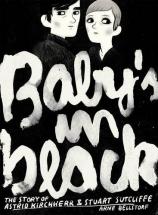Baby's in Black
Review
Baby's in Black
It is rare among graphic novels to find a publisher who continually, time and again, produces well-written and conceived, thought-provoking sequential literature. Self Made Hero, a relatively young British publisher involved in either English-language editions of various award-winning European titles or original contributions by both recognized and debut talent, is deserving of that praise alongside similar North American venues such as Top Shelf or Humanoids. Having experienced the privilege of reviewing its Gonzo biography of Hunter S. Thompson, I can say that reading Arne Bellstorf's Baby's in Black was a welcome follow-up.
Releasing Baby's in Black to English-speaking audiences is a smart move by Self Made Hero not only because the book is simply a good read, but also because of the built-in audience for anything Beatle-mania. Diehard Beatle fans will immediately recognize the name of Stuart Sutcliffe, the enigmatic fifth member of the band and original bass player from the Beatles’ early days in Hamburg. Although television documentaries and films have chronicled this episode in Beatle history, perhaps immortalized for either good or bad by actor Stephen Dorr's portrayal in the 1994 film Backbeat, the arrival of Baby's in Black is an introspective look at a relationship formed within pre-Beatle hysteria, not one forged because of it.
Some readers may be alarmed by the high contrast, stark line art of Bellstorf from the beginning. Heavy charcoal and graphite, while beautifully utilized for casting cityscapes, outdoor environments, or the recognizable visages of John, Paul, and George, can fall somewhat short in profiling the lesser known visualizations of Kirchherr, Sutcliffe, and their German companions. In fact, if there is one major criticism of Baby's in Black it is that the artwork allows for very little variation in facial construction or rendition, as most of the characters share the same facial structure, hairstyles, eye shapes, mouths and noses. As a result, the text can become confusing in attempting to identify who the characters are apart from their gender. This style and approach succeeds quite well, however, in the intimate moments between Astrid and Stuart or in the transitional, sequences of non-human interactions.
For audiences unfamiliar with the relationship, the story opens with Klaus Voormann, the presumed protagonist of the narrative, and his awkward, perhaps already failed romance with Astrid. At first, Klaus is also the narrator, the only window for the reader to experience the impact of American rock-and-roll interpreted by the Beatles on the static lives of Hamburg's citizens. The first twenty or so pages of Baby's in Black are told through his perspective. Bellstorf hints at shared pasts and moments already long gone between Klaus and Astrid, but never develops them beyond mere passing mentions.
In terms of character development and story progression, the narrative's strengths lie with Astrid and her experiences. It makes sense that since Bellstorf spent time with Kirchherr that the graphic novel would obviously reflect an Astrid-centric approach. Yet, one of the perhaps unintentional consequences of this focus is that the other characters are merely shallow husks. Audiences don't experience John Lennon or Paul McCartney or George Harrison as they were in 1960, but rather through the lens of their own cultural baggage and perceptions of Beatle fascination shaped and molded by successive generations of fans for over fifty years. While this would be hard to avoid given the status and iconic nature of both the individuals and the band themselves, the same unfortunate neglect in evolving the characters beyond mere avatars carries over to Stuart Sutcliffe as well. Apart from learning that Stuart possessed an artistic background and was only tangentially united with the band, audiences grasp little more about the individual, his passions, and his all-too tragic and early demise. One consequence of this is that the book is largely emotionless save the artistic passion that is conveyed and exhibited brilliantly by Kirchherr herself.
Fortunately, it appears that Self Made Hero recognized this potential setback or limitation in the novel's structure and preemptively moved to include an excerpt from a scholarly biography of Kirchherr published in 2010, which provides important and necessary context and cultural relevance for the 1960 encounter. Serving as a nice intellectual and ideological counterweight to the book, Jon Savage's essay discusses the significance of youth culture, pop modernism, and the Hamburg Exis. Some audiences may actually benefit from reading this concluding section first, while others may gain greater insight into the novel on a second read-through with the knowledge in hand. Either way, Baby's in Black is an exciting and engaging installment in the publisher's ongoing graphic biography series.
Reviewed by Nathan Wilson on July 9, 2012
Baby's in Black
- Publication Date: March 1, 2011
- Genres: Graphic Novel
- Paperback: 224 pages
- Publisher: SelfMadeHero
- ISBN-10: 1906838267
- ISBN-13: 9781906838263



